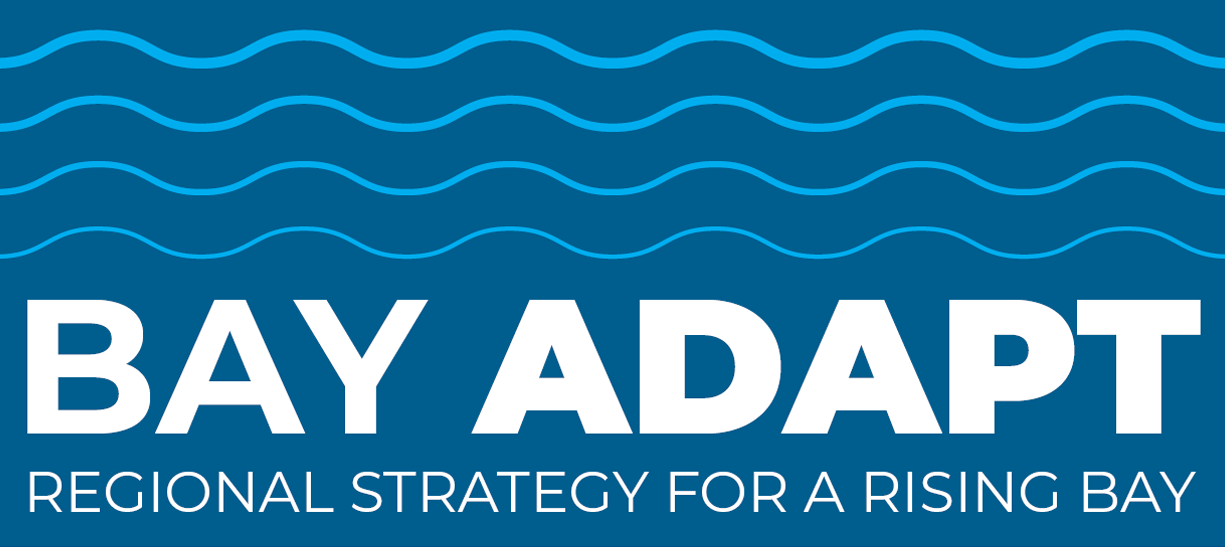Add page content here.
Meet our Bay Adapt Award Recipients!
- By: Justin Ebrahemi
- | August 13, 2024
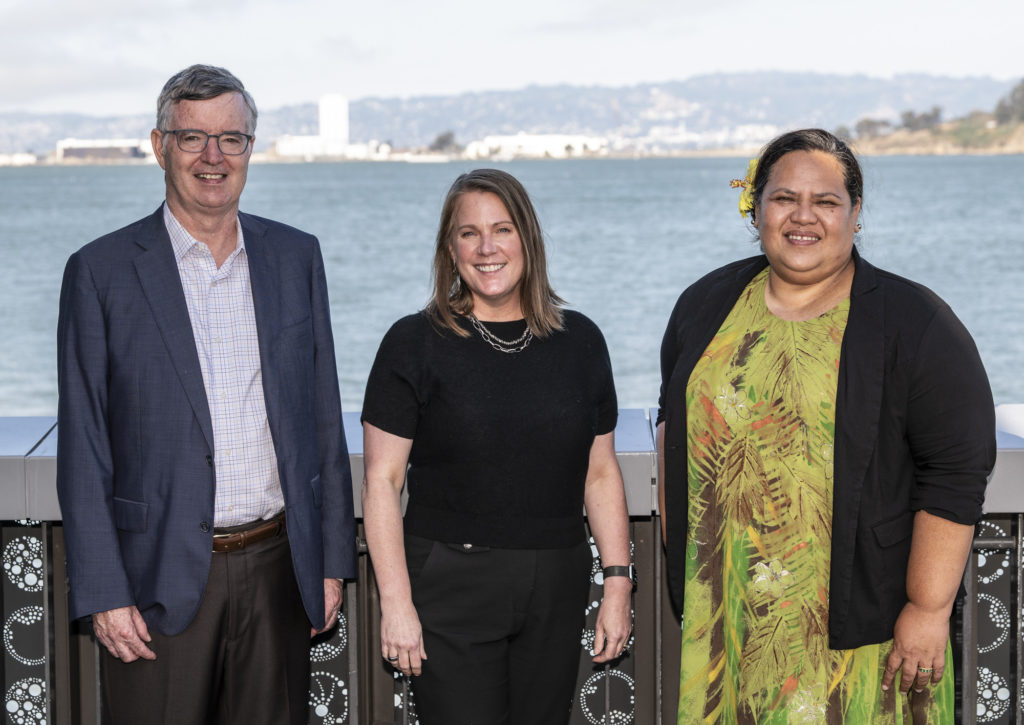
The Bay Area’s groundbreaking sea level rise adaptation initiatives are shaping a more sustainable future in the face of rising seas, thanks to visionary adaptation leaders. BCDC’s Bay Adapt awards honors exemplary climate change leaders who are making significant progress in addressing the critical challenges posed by rising sea levels. On August 8th, at the Exploratorium, we celebrated these exceptional individuals who have displayed excellence and passion in preparing the Bay Area and our communities for rising sea levels: Supervisor Dave Pine, Violet Saena, and Dr. Kris May.
These visionaries are dedicated to protecting and stewarding our unique shorelines and the diverse communities who live, work, and play around them. Their efforts are advancing BCDC’s Joint Platform to protect both people and the environment — natural and built — from the impacts of rising sea levels.
Get to know our Bay Adapt Awardees and their amazing work by reading this Q&A!
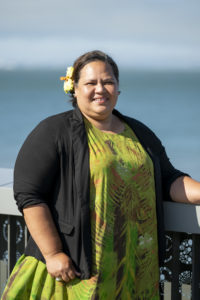
Violet Saena is the founder and executive director of Climate Resilient Communities (CRC), a BCDC partner organization that supports under-resourced communities of color at the frontline of climate change and sea level rise. Violet also serves as the equity program manager for the Bay Area Climate Adaptation Network, and serves as an environmental justice advisor for BCDC.
Violet’s dedication to elevating community voices and responding to environmental injustice is deeply rooted in her lived experiences in the South Pacific. She has served as an international climate change expert with the United Nations’ Least Developed Countries and Small Island States to protect communities from the impacts of climate change. She now works in the Bay Area, partnering with governments, research institutions, and community-based organizations to build community capacity to respond to climate change and sea level rise.
How did you get your start working on climate adaptation efforts in the Bay Area?
In 2005, I moved to the United States from Samoa, a small South Pacific island nation where I conducted climate adaptation work as their first Climate Change Officer. Some of the communities I worked with were displaced or about to be. My projects included building priority solutions such as seawalls or encouraging communities to move away from the shoreline. Through these experiences, I became super familiar with the issues and solutions of rising sea levels.
In the United States, I pursued a Masters at Duke University, where I studied sea level rise vulnerability for communities in East Palo Alto. It was through this research that I learned about how under-resourced East Palo Alto is to engage in sea level rise planning. After Duke, I participated in the Resilient By Design Challenge in partnership with the City of East Palo Alto, which hit off my local community adaptation work here.
How did Climate Resilient Communities get its start?
I started to bring people together to discuss sea level rise and how it will affect their livelihoods in 2019. The community wanted to engage in these conversations, but they didn’t know how to. There wasn’t any infrastructure or programs for receiving information on local sea level rise issues or how to be at the table. So, I responded to a Request for Proposals with the County of San Mateo for funding to form a climate change community team in East Palo Alto. This team became the structure where other community leaders can come together and develop programs to increase climate education and participation for climate adaptation. Eventually, we formed the East Palo Alto Climate Change Community Team.
Later that year, I got another grant from San Mateo County and CalTrans to conduct a vulnerability assessment to learn about our community’s capacity to respond to climate threats like sea level rise. This helped identify strategies to help alleviate some of the impacts of climate hazards that East Palo Alto has, like flooding, extreme heat, and heavy rainfall.
How does your work support under-resourced communities of color at the frontline of climate change and sea-level rise? Do you have an example of a climate change adaptation project?
Climate Resilient Communities looks at the adaptive capacity of the community. We have to look at the injustices that limit the community’s capacity to respond to issues like sea level rise. For example, how many families in East Palo Alto can afford flood insurance? How many families can afford to replace a vehicle if it’s destroyed?
The climate change solutions that CRC employs are community-identified and led. One of these strategies was to build rain gardens and cistern systems on homeowners’ property. We can reduce runoff from the Bay by capturing rainfall on roofs in East Palo Alto, and the garden can hold the water during our drought season. This can also be a solution for food security. In conducting our vulnerability assessment, the community wanted this solution because the gardens are designed for multiple benefits. CRC is currently implementing a million dollar project from the Coastal Conservancy to test this local solution, with the hope to replicate in other communities that we serve.
What other communities does Climate Resilient Communities serve?
We started in East Palo Alto, but now we work in North Fair Oaks, Belle Haven Menlo Park, and San Bruno. Next, we are working on building a climate change team in South San Francisco in partnership with Rise South City and expanding our work in Santa Clara County.
How do you leverage your expertise and experience as an Environmental Justice advisor for BCDC? What are you working on with BCDC currently?
I contribute my experience on building collaboration in my advisory role to BCDC. The vulnerability assessment work in East Palo Alto is a bottom-up approach to adaptation planning. I think many existing programs are top down, but I bring in a lens of planning for underserved communities with the solutions that they want to see. I’m from a place that’s disproportionately impacted by climate change. My role is to remind government to change their practices to be more equitable and address the existing disparities and community concerns.
How does CRC collaborate with governments, research institutions, and other community-based organizations to build community capacity to respond to climate change and sea level rise? Why are these cross-sectional partnerships important to adaptation work?
One of my biggest concerns are the frontline communities who will be displaced if we don’t act now. This concern is beyond the capacity of any one organization to address. There are government entities and research institutions that work to alleviate these vulnerabilities, but I witnessed much disconnect between these agencies and communities. Part of my work is to bridge the gap among climate science, governance, and communities because I see the value of everyone working together. It’s critical to have a regional approach and bring everyone to the table. So that’s why CRC works with research institutions to address data gaps and understand the science. We work with city managers and staff to secure resources, and we listen to community members because they have expertise and knowledge. Having everyone at the table is key for designing more effective and equitable adaptation strategies.
What keeps you inspired and hopeful for the future of climate change adaptation work in East Palo Alto?
What keeps me hopeful is the resiliency of the community. When I sit back in a meeting and community members are making decisions for residents and future generations, when I hear them advocate for issues that matter to them because their families live here, when they respond to city managers and get engaged. That’s what gives me hope.
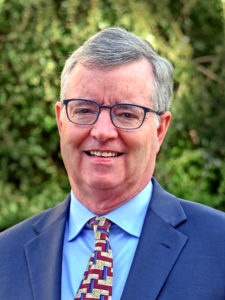 San Mateo County Supervisor Dave Pine has represented District 1 since 2011, and served as Board president three times. Prior, he served as Trustee of both the Burlingame School District Board and the San Mateo Union High School District Board.
San Mateo County Supervisor Dave Pine has represented District 1 since 2011, and served as Board president three times. Prior, he served as Trustee of both the Burlingame School District Board and the San Mateo Union High School District Board.
He has worked extensively on the intersecting issues of flood control, sea level rise and tidal land restoration throughout multiple roles, including Chair of the SF Bay Restoration Authority, founding chair of the San Mateo County Flood and Sea Level Rise Resiliency District (known as One Shoreline—the first county-level agency in the state to directly focus on sea level rise), and as a BCDC Commissioner.
Supervisor Pine is also the founding chair of Peninsula Clean Energy, which provides
San Mateo County residents and businesses with cleaner energy at lower rates, and has served on the Caltrain Joint Powers Board and the San Mateo County Transit District Board. Known as a leading voice for children and families, Supervisor Pine has advocated for affordable and accessible childcare through his role as Co-Chair of the Child Care Partnership Council and Build Up San Mateo County. Supervisor Pine also led efforts to establish the San Mateo County LGBTQ+ Commission, the first of its kind in the state.
Originally from New Hampshire, Pine is a graduate of Dartmouth College, where he was awarded a Harry S. Truman scholarship, and the University of Michigan Law School. He lives in Burlingame with his wife Jane and their two sons.
Can you provide an overview of your work to support sea level rise adaptation in San Mateo County and across the region? Specifically, how were you involved in OneShoreline’s Planning Guidance Policy to Protect and Enhance Bay Shoreline Areas of San Mateo County?
I wear many hats. With the San Francisco Bay Authority, my focus is on tidal wetland restoration, aiming to make the Bay as healthy as possible. In San Mateo, where I chair the County’s flood control district known as One Shoreline, my role more broadly looks at sea level rise, groundwater rise, and flooding risk—on both the bayshore and the coast side. San Mateo county is the most exposed county to sea level rise in California, so we have plenty of work to do.
In Southern San Mateo County and East Palo Alto, many at-risk properties belong to lower socioeconomic communities, making their voices critical as we design future protections.
I believe we’ve made tremendous progress in San Mateo and regionally in addressing sea level rise and laying the groundwork for solutions. BCDC has done excellent work developing foundational documents for counties, and the Regional Shoreline Adaptation Plan will be very powerful at the local level.
What are some of the barriers you may have faced in addressing climate change challenges, and how are you working to resolve these barriers?
Sea level rise impacts everyone, regardless of where we live. In San Mateo, residents who do not live along the shoreline may be less inclined to prioritize the issue. Although sea level rise may not seem applicable to residents who live in the hillsides, it is critical because most of our major infrastructure is located along the coastline. In other areas of the county, it’s been a challenge to develop a sense of urgency in dealing with this issue. While the gradual rise of the bay may not be immediately visible, it represents a slow-moving emergency that is approaching. Inspiring people to recognize and address these issues now remains a challenge.
What are you most excited about for the future of SLR adaptation or climate change work? What inspires you?
There is a mosaic of efforts around the Bay. BCDC’s shoreline adaptation work is bringing uniformity and synthesis across these efforts. The County of San Mateo contributes to BCDC at the local level while also providing guidance at the regional level.
My vision for the future would be an approach to sea level rise where we have the right defenses based on facts on the ground. Each segment of the shoreline will require a tailored response, considering the unique geography and economic needs of each area. We must develop solutions that are both sensitive to these local conditions and effective in providing the necessary defenses.
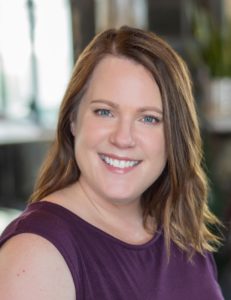 Dr. Kris May is the CEO and Founder of the Pathways Climate Institute, a research-based consulting firm that helps communities understand their climate change related risks, develop adaptation plans, and work toward filling science-based data gaps that hinder decision-making. Dr. May specializes in climate change resilience and adaptation planning in coastal communities, and has worn many hats on Bay Area projects, including leading the FEMA San Francisco Bay Coastal Study for over a decade, supporting the Adapting to Rising Tides program since 2011, and most recently serving as the lead planner for the Port of San Francisco’s Waterfront Resilience Program.
Dr. Kris May is the CEO and Founder of the Pathways Climate Institute, a research-based consulting firm that helps communities understand their climate change related risks, develop adaptation plans, and work toward filling science-based data gaps that hinder decision-making. Dr. May specializes in climate change resilience and adaptation planning in coastal communities, and has worn many hats on Bay Area projects, including leading the FEMA San Francisco Bay Coastal Study for over a decade, supporting the Adapting to Rising Tides program since 2011, and most recently serving as the lead planner for the Port of San Francisco’s Waterfront Resilience Program.
Her firm’s research on rising groundwater, conducted in partnership with the San Francisco Estuary Institute, and on future extreme precipitation, in collaboration with the Lawrence Berkeley National Laboratory, can benefit all Bay Area communities as they plan for an uncertain future. Kris also contributes her expertise through pro-bono services, including serving as a lead author for the 4th and 5th National Climate Assessment, and serving as a coastal engineer on BCDC Engineering Criteria Review Board.
How did Pathways Climate Institute (Pathways) get started?
I have worked in the Bay Area for a long time as a coastal engineer, scientist, and project manager. While understanding the impacts of climate change was always part of my projects, I decided that I wanted to focus all of my attention on climate adaptation. Eight years ago, I left my previous employer and founded Pathways Climate Institute . It was a huge leap. Some thought I was crazy for wanting to build my own company, and others found it inspiring. This decision has given me the freedom to work on research and projects that are impactful. I love my work and I feel it truly makes a difference! It has been wonderful to watch my firm grow and support initiatives that are moving that needle on climate change adaptation in the Bay Area. Our work is innovative, and I hope we can expand it to other jurisdictions.
How does your firm support communities to adapt to climate change? What are some examples of work that Pathways Climate Institute is supporting?
To support communities adapting to climate change, our main focus is often on the science. We believe that all communities should have free access to the best-available data to support their adaptation efforts. It is equally important that communities understand the data so they can make informed decisions and investments over time to adapt.
We work with our clients to understand where they have data gaps, like our rising Bay Area groundwater research with Kristina Hill and San Francisco Estuary Institute. We began collaborating on groundwater rise in 2016 as part of the Resilient By Design effort, and we have continued to advance the science and make our data freely available. We found that a better understanding of groundwater rise can inform more effective sea-level rise adaptation strategies, especially in low-lying vulnerable communities. We’re currently working on our fifth county, Contra Costa County, and this data should be added to our growing body of rising groundwater research before the end of 2024.
Last year, Pathways released a study in collaboration with researchers at Lawrence Berkeley National Laboratory that assessed how extreme precipitation in the Bay Area will change as our climate continues to warm. After years of research during and extended drought, it was validating to see back-to-back storms in early 2023 that agreed with our research. These large storms are already increasing in intensity. And the 2023 storms highlighted the importance that communities need to not only consider sea level rise, but also consider rising groundwater and extreme precipitation as they develop adaptation plans.
What do you find most valuable to your work in climate change adaptation? How is your scientific research and data bringing people together?
Addressing climate hazards is a significant challenge. It requires collaboration among experts from various disciplines to help people understand what these hazards could look like and how to effectively respond. I enjoy helping people understand the science and effectively apply it. Pathways not only fills in science gaps, but also collaborates with communities to interpret the real-world implications of climate-related impacts on the ground. We help them understand how these impacts may change over time, and how to use that information to design a flexible and often multi-generational adaptation plan.
I have been working in the Bay Area for a long time, and I have been grateful to build a large network across different agencies, communities, and firms with people who want to push forward in the climate adaptation space. I am also grateful that people consider us a trusted advisor in this space. I am working on Oakland and Alameda adaptation projects now, working across multiple government agencies and community organizations who have formed the Oakland Alameda Adaptation Committee to look at how the shorelines can be transformed over time to address the compounding climate hazards.
Getting all these agencies to work together is not always easy. They all have their own challenges and interests. I like to think that living in Alameda, combined with my understanding of climate and flooding hazards, and the relationships I have built with many of the people and agencies engaged in the project, has enabled me to help them collaborate effectively. The Oakland Alameda Adaptation Committee is such a great example of multi-jurisdictional collaboration. It’s about relationship-building and bringing everyone along in the process to keep things moving forward.
What are some learnings or insights you have as a result of working on the Oakland Alameda Adaptation initiative?
It has been important to have the City of Alameda step up and lead these projects. They have successfully secured grant funding for three separate grants, which are supporting two near-term adaptation projects and the development of a long-term plan for Alameda, a portion of the Port of Oakland, and deep east Oakland. However, continued collaboration will be essential to secure additional funding. The team has been looking into different governance models that could help sustain this work over the long-term. This part of the project has been particularly interesting to me. As a scientist, I am less experienced with governance, so I have been learning about its critical role and how that relates to adaptation funding.
It has also been great to see the strong local interest in implementing nature-based solutions along the Alameda and Oakland shorelines, as well as in the creeks and tributaries. We are still in the weeds of developing potential long-term adaptation options, and it is exciting to see what the Committee and the consultant team are bringing to the table.
How has Pathways’s Suisun City case study that was prepared with BCDC been received by the local community?
Pathways and BCDC selected Suisun City for an adaptation planning case study because, at the time, the city had not yet conducted extensive research related to sea level rise vulnerability and risks. The 2019 case study was intended to test an adaptation planning framework, so we did not work directly with Suisun City staff or the community. The final report includes resilience and planning principles, an existing conditions assessment, initial adaptation ideas, and suggestions on how to engage the community and partners. It was rewarding to share this work with Suisun City staff after it was complete, enabling them to jumpstart their own efforts. BCDC has been great in providing opportunities for us to present our findings at different community events, and the community has been really proactive in wanting to move adaptation solutions forward. In particular, Sustainable Solano and Emily Corwin, formerly of the Fairfield-Suisun Sewer District have been local champions in advancing these projects.
What are you most excited about for the future of sea level rise adaptation or climate change in the Bay Area? What inspires you?
I am so much more optimistic lately. It looks like global greenhouse emissions related to fossil fuel emissions may have peaked, which means we may finally be seeing a downward trend in greenhouse gas emissions. If we continue on this downward trend, it gives me hope that we will not end up on the “worse case” climate change projections, meaning that the adaptation that is needed over the next century is more doable.
I know for a lot of communities, trying to adapt to that “worse case scenario” is extremely challenging. Where I live in Alameda, for example, that worst case scenario of seven feet of sea level rise is scary. Our houses would be below sea level. So I’m hopeful this will not be the case.
I love the momentum the Bay Area has in collaborating and planning for the future of our cities. Our region is developing resilience guidelines for urban planning that will accommodate our changing climate. People are thinking about a whole range of transformation solutions — not just trying to build a levee to keep the Bay out. Making our cities more resilient to climate change will require us to rethink how – and where — we should design, build, and adapt. These conversations are already happening in the Bay Area, which is really exciting. My hope is that the next generation is proud of the work we have accomplished – that we have pushed the needle in the right direction and left things better than we found them.
Other Recent Posts

Justin Ebrahemi
Justin Ebrahemi is the Director of Marketing & Communications at Greenbelt Alliance, where his experience in nonprofit leadership, environmental policy research, and journalism helps diversify the field of environmental advocacy.
